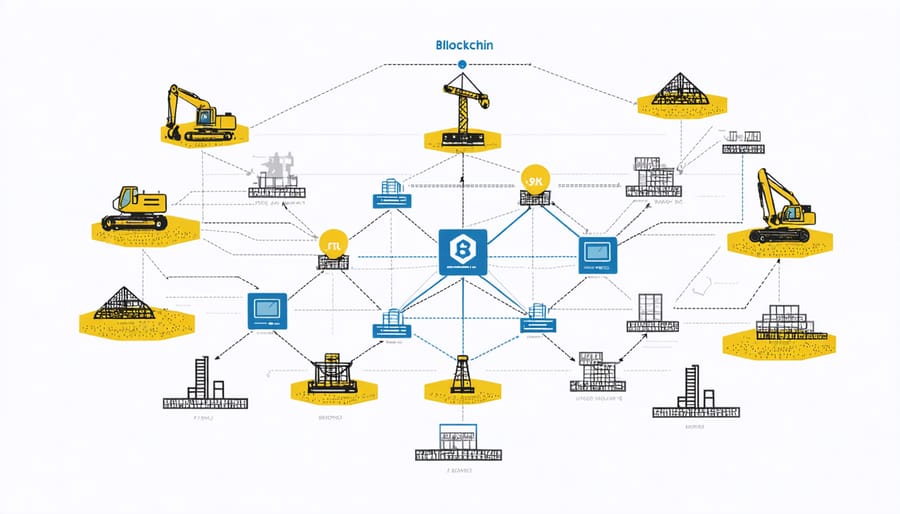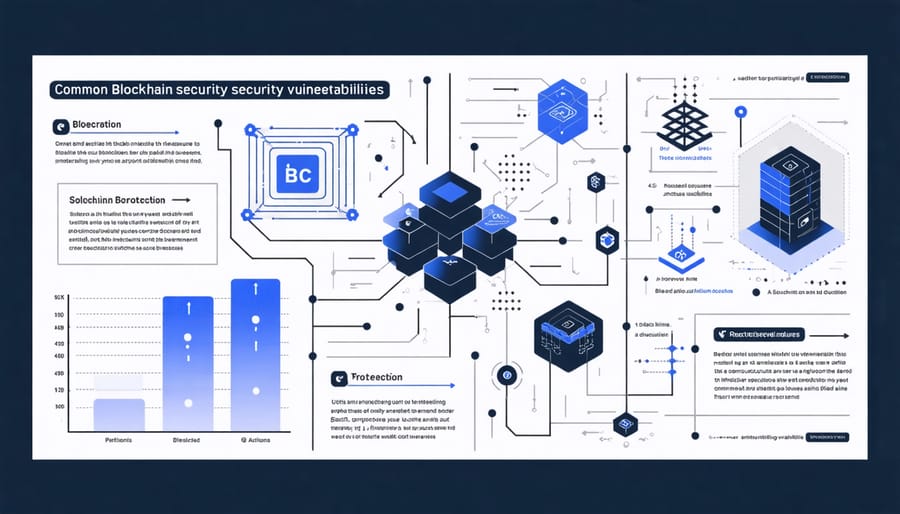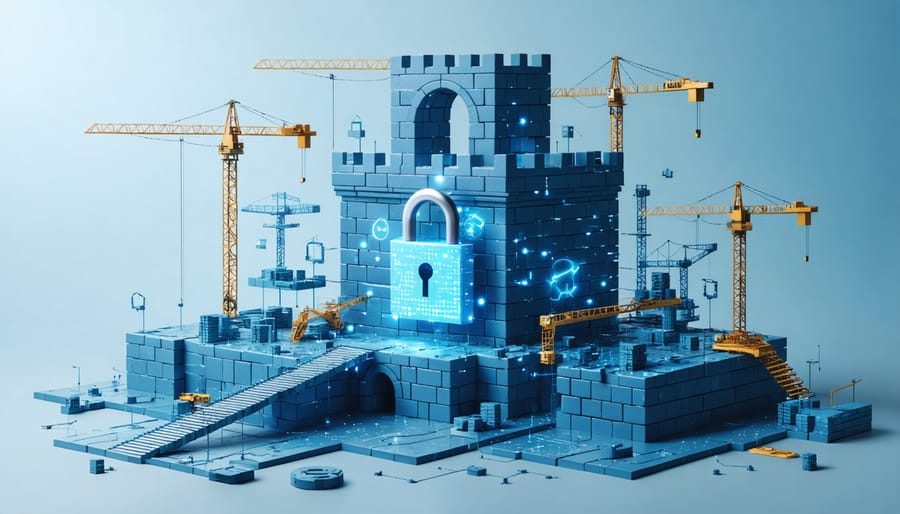Blockchain technology revolutionizes construction site protection and data security through its inherent cryptographic foundations, yet questions about its true security persist in the building sector. While the distributed ledger technology offers unprecedented transparency and immutability for construction project data, its implementation demands careful consideration of both strengths and vulnerabilities.
Modern blockchain networks employ advanced consensus mechanisms and cryptographic algorithms that make tampering with construction records virtually impossible. Each block in the chain contains a unique cryptographic hash, creating an unbreakable link to previous entries and ensuring data integrity across the entire project lifecycle. This mathematical foundation, combined with decentralized validation processes, provides a robust security framework that traditional centralized databases cannot match.
However, the security of blockchain systems extends beyond mere technological aspects. The construction industry must evaluate practical implementation challenges, including access control protocols, smart contract vulnerabilities, and integration with existing project management systems. Understanding these security dimensions is crucial for construction professionals seeking to leverage blockchain’s potential while maintaining robust data protection standards.
The Architecture of Blockchain Security
Decentralization and Data Distribution
Decentralization stands as a cornerstone of blockchain’s robust building data security framework. Unlike traditional centralized databases where information resides on a single server or cluster, blockchain distributes data across multiple nodes within a peer-to-peer network. This architectural approach eliminates single points of failure that could compromise entire systems.
In construction project management, this distributed structure ensures that critical data – from material specifications to compliance documentation – remains accessible and verifiable even if individual nodes fail. Each participant in the network maintains an identical copy of the ledger, creating redundancy that safeguards against data loss and unauthorized manipulation.
The distributed nature of blockchain also enhances data integrity through consensus mechanisms. Before any new information is added to the chain, multiple nodes must verify and agree on its validity. This process makes it exceptionally difficult for malicious actors to compromise the system, as they would need to simultaneously control a majority of nodes to alter records.
For construction firms managing multiple projects across different sites, this decentralized approach ensures consistent data availability and integrity. Even in the event of local system failures or cyber attacks, project information remains secure and accessible through other network nodes, maintaining operational continuity and protecting valuable project data.

Cryptographic Protection
Blockchain’s security foundation lies in its robust cryptographic protection mechanisms, which are essential for maintaining data integrity in construction project documentation. The technology employs advanced cryptographic hash functions, primarily SHA-256 (Secure Hash Algorithm 256-bit), to create unique digital fingerprints of each transaction or data block.
These hash functions transform construction project data into fixed-length strings of characters, making it computationally infeasible to reverse-engineer the original information. Each block contains not only its own hash but also the hash of the previous block, creating an unbreakable chain of information. This characteristic is particularly valuable for maintaining the authenticity of building specifications, contract documents, and change orders.
Public key cryptography further enhances security by enabling secure digital signatures. Project stakeholders use their private keys to sign transactions, while public keys verify these signatures, ensuring that only authorized parties can modify project records. This system creates an immutable audit trail for all construction documentation.
The combination of hash functions and asymmetric encryption provides a dual layer of protection. Even if a malicious actor attempted to alter a single piece of data, such as material specifications or cost records, the change would invalidate all subsequent blocks, making unauthorized modifications immediately apparent to all network participants.
These cryptographic mechanisms ensure that once construction data is recorded on the blockchain, it remains tamper-evident and verifiable throughout the project lifecycle.
Real-World Security Applications in Construction

Smart Contract Security
Smart contracts serve as self-executing digital agreements that automatically enforce and document project milestones, approvals, and transactions within the blockchain network. In construction projects, these contracts ensure immutable documentation of critical processes, from initial design approvals to final inspections.
By utilizing smart contracts, construction teams can establish predetermined conditions that must be met before proceeding to subsequent project phases. For example, when an architect submits design revisions, the smart contract automatically notifies relevant stakeholders and records their digital signatures. Once all required approvals are secured, the contract automatically triggers the next phase of work.
The security of smart contracts stems from their autonomous execution and tamper-proof nature. Each transaction and approval is cryptographically sealed and distributed across the network, making it virtually impossible to alter records retroactively. This creates an audit trail that withstands legal scrutiny and helps resolve potential disputes.
Leading construction firms have implemented smart contracts for managing subcontractor agreements, material procurement, and quality control processes. These implementations have demonstrated significant improvements in documentation accuracy and reduced approval delays by up to 70%.
However, it’s crucial to note that smart contracts require careful programming and thorough testing before deployment. Construction companies should work with experienced blockchain developers to ensure contract logic accurately reflects project requirements and includes appropriate fail-safes for exceptional circumstances.
Supply Chain Verification
Blockchain technology has revolutionized supply chain verification in the construction industry by creating an immutable record of material sourcing, transportation, and handling. This innovation is particularly crucial for safeguarding critical infrastructure projects where material authenticity directly impacts structural integrity and safety.
The system works by creating digital “fingerprints” for construction materials at each stage of their journey. Every transaction, quality check, and transfer of custody is recorded in real-time, making it impossible to substitute inferior materials without detection. For instance, when steel beams leave the manufacturer, their specifications, testing certificates, and origin details are encrypted and stored on the blockchain.
This verification process extends beyond basic tracking. Smart contracts automatically validate compliance with project specifications and regulatory requirements. If materials don’t meet predetermined quality standards or lack proper certification, the system flags these issues immediately, preventing their use in construction.
Major contractors have reported significant improvements in material verification efficiency, with some achieving up to 85% reduction in verification time and nearly eliminating instances of counterfeit materials. The technology’s ability to provide instant verification of material authenticity has proven particularly valuable in large-scale infrastructure projects where material failure could have catastrophic consequences.
Access Control Management
Access control management in blockchain-based construction projects provides a robust framework for controlling and tracking who can view, modify, or interact with project data. Through smart contracts and cryptographic protocols, project administrators can establish granular permission levels for different stakeholders, from contractors and suppliers to architects and owners.
The system enables role-based access control (RBAC), where permissions are assigned based on stakeholder roles and responsibilities. For example, contractors might have access to specific work package data, while project managers can oversee all construction activities. This hierarchical structure ensures that sensitive information remains protected while maintaining transparency where needed.
Digital signatures and private keys serve as secure authentication mechanisms, allowing stakeholders to prove their identity and authorization level without compromising security. Each transaction or data modification is permanently recorded on the blockchain, creating an immutable audit trail of who accessed what information and when.
Furthermore, blockchain’s distributed nature means that access rights can be managed across multiple project sites and organizations without compromising security. Smart contracts automatically enforce access rules, reducing the risk of unauthorized data exposure or manipulation. This is particularly valuable in large-scale construction projects involving numerous subcontractors and suppliers.
The system also supports dynamic access management, allowing project administrators to modify permissions as roles change or new stakeholders join the project, ensuring security remains tight throughout the project lifecycle.
Potential Vulnerabilities and Solutions

51% Attack Risk Assessment
A 51% attack represents one of the most significant security concerns for construction-based blockchain networks, particularly in consortium or private networks where multiple stakeholders collaborate. This type of attack occurs when a single entity or coordinated group gains control of more than half of the network’s computational power, potentially enabling them to manipulate transaction records or building data.
In the construction industry, where multiple contractors, suppliers, and stakeholders participate in the network, preventing majority attacks requires careful consideration of node distribution and validation mechanisms. Industry experts recommend implementing a robust consensus mechanism specifically designed for construction applications, such as Proof of Authority (PoA) or modified Proof of Stake (PoS) systems.
To mitigate 51% attack risks, construction organizations should:
– Distribute network nodes across multiple trusted participants
– Implement strict node validation requirements
– Establish clear governance protocols for network participation
– Regularly audit network participation and voting power
– Maintain transparency in node operation and validation processes
According to recent industry analysis, construction blockchain networks that implement these safeguards have shown significantly reduced vulnerability to majority attacks. Additionally, incorporating smart contracts with built-in security protocols adds an extra layer of protection against potential manipulation attempts.
For maximum security, organizations should regularly assess their network’s node distribution and adjust security parameters based on participation levels and risk assessments.
Smart Contract Vulnerabilities
While blockchain technology provides robust security features, smart contracts – the self-executing programs that automate transactions on the blockchain – can introduce vulnerabilities if not properly implemented. In the construction industry, where smart contracts manage project payments, supply chain verification, and document authentication, understanding these potential weaknesses is crucial.
Common vulnerabilities include reentrancy attacks, where malicious code repeatedly calls a function before the first execution completes, potentially draining funds from the contract. Overflow and underflow errors in numerical calculations can also compromise contract integrity, affecting payment systems and quantity measurements in construction projects.
Access control issues present another significant risk, particularly in multi-stakeholder construction projects. Inadequate permission settings can allow unauthorized parties to execute critical functions or modify contract parameters. Time manipulation vulnerabilities can also affect contract execution, especially in time-sensitive construction milestones and payment schedules.
To mitigate these risks, construction organizations should implement comprehensive security audits of smart contracts before deployment. This includes code review by experienced blockchain developers, automated vulnerability scanning, and thorough testing in controlled environments. Regular updates and maintenance of smart contracts are essential, as is the implementation of fail-safe mechanisms that can pause contract execution if suspicious activity is detected.
Industry best practices recommend using standardized, well-tested smart contract templates and maintaining detailed documentation of all contract functions and security measures.
Best Practices for Implementation
To ensure secure blockchain implementation in construction projects, organizations must follow a structured approach that addresses both technical and operational aspects. Start by conducting a thorough security assessment of existing systems and identifying potential vulnerabilities before integration. This evaluation should align with established smart security implementation protocols.
Establish robust access control mechanisms by implementing multi-signature requirements for critical transactions and role-based permissions for different stakeholders. Construction firms should maintain comprehensive documentation of all security protocols and regularly update them to address emerging threats.
Deploy private or permissioned blockchain networks rather than public networks when handling sensitive project data. This approach provides better control over participant verification and data access. Implement regular security audits and penetration testing to identify potential weaknesses in the blockchain infrastructure.
Ensure all team members receive proper training on blockchain security practices and establish clear protocols for managing private keys and digital signatures. Create detailed incident response plans that outline procedures for addressing security breaches or system failures.
Consider implementing redundancy measures and backup systems to maintain data availability and integrity. Regular system updates and maintenance should be scheduled during off-peak hours to minimize disruption to ongoing construction operations while maintaining security standards.
Blockchain technology represents a significant advancement in securing construction data management, offering robust solutions to long-standing industry challenges. The immutable nature of blockchain, combined with its distributed architecture, provides unprecedented levels of data integrity and transparency throughout the construction lifecycle.
The security benefits of blockchain in construction are clear and compelling. From protecting sensitive project documentation to ensuring the authenticity of material certifications, blockchain creates an unalterable record that stakeholders can trust. The technology’s ability to track changes, verify transactions, and maintain a comprehensive audit trail significantly reduces the risk of fraud and data manipulation.
Looking ahead, the construction industry is poised to see increased adoption of blockchain-based solutions. As more organizations recognize the value of secure, decentralized data management, we can expect to see broader implementation across various construction processes. The integration of smart contracts and automated compliance verification will further enhance security protocols while streamlining project execution.
However, successful implementation requires careful consideration of infrastructure requirements, staff training, and industry-wide standardization. Organizations must develop clear strategies for blockchain adoption, focusing on both technical security measures and operational protocols. With proper planning and execution, blockchain technology can significantly enhance data security while improving project efficiency and collaboration across the construction sector.
The future of construction data security lies in embracing these technological advances while maintaining a balanced approach to implementation and risk management. As the technology matures, its role in securing construction data will only become more crucial.

